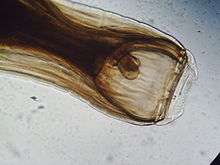Strongylus vulgaris
| Strongylus vulgaris | |
|---|---|
 | |
| Close-up of Strongylus vulgaris mouthparts. | |
| Scientific classification | |
| Kingdom: | Animalia |
| Phylum: | Nematoda |
| Class: | Chromadorea |
| Order: | Strongylida |
| Family: | Strongylidae |
| Genus: | Strongylus |
| Species: | S. vulgaris |
| Binomial name | |
| Strongylus vulgaris | |
Strongylus vulgaris (large strongyles),[1] commonly known as the blood worm,[2] is a common horse parasite in the phylum Nematoda. It looks like a long worm with a large biting mouth, as shown in the picture. They are usually reddish in color because of all the blood they take from the equine host.[1] This nematode is considered to be one of the "most pathogenic" of the large strongyles subphylum and is distributed worldwide, wherever there are grassland and temperate environments.[3]
Life cycle
It generally lives in the large intestine with larvae that migrate into the mesenteric arteries.[3] It can live outside of its host in the early stages of life up to its larval life, which is then ingested by the horse from the grass or contaminated water. Once ingested, it migrates to the intestinal tract and fully matures. This parasite in particular also travels to the blood vessels of the intestines, where it can live up to 6 months.[4]
Clinical symptoms
Symptoms can range depending on how severe the infection is. The mild cases can cause diarrhea, weakness, anorexic, anemia if there is significant blood loss, and abdominal discomfort. Severe cases can show signs of having severe colic, rupture of the intestines, and death.[5]
Treatment
Dewormers that have ivermectin or moxidectin are the most effective against these parasites.[6] Treating a horse with regular dewormer when they have the worms inside of them may cause the worms to migrate all at once, causing rupture of the intestines and lead to death.[7] A deworming schedule should be discussed with a veterinarian.
Prevention
Horses are able to pick up this parasite from feces contaminated food and water. To avoid this, it is best to clean water tanks and pick out pastures often, avoid feeding on the ground, and avoid overstocking pastures.[8] As foals can be extremely susceptible to this parasite, it is best to treat broodmares before they give birth and move them to uninfected pastures to avoid transfer.
References
- 1 2 "Large Strongyles (Strongylus vulgaris, S. equinus, S. edentatus)". www.animalworldnetwork.com. Retrieved 2016-04-28.
- ↑ Disease Information. 2001. "Merial" http://nz.merial.com/horse_owners/disease/strongy_lg.html
- 1 2 De Ley, P. & Blaxter, M. "Systematic Position and Phylogeny." The Biology of Nematodes. Lee D. L. (Ed.). London & New York: Taylor & Francis, 2002. 1-30.
- ↑ "Strongyles, Roundworms, Tapeworms, & More: Common Internal Equine Parasites". www.drsfostersmith.com. Retrieved 2016-04-28.
- ↑ "Large Strongyles, Equine". www.vetmedclinic.com. Retrieved 2016-04-28.
- ↑ "Parasites And Pastures". TheHorse.com. Retrieved 2016-04-28.
- ↑ "The Worm That Kills - And Why Only Two Worming Chemicals Can Stop It - The Horse's Back". The Horse's Back. 2014-04-17. Retrieved 2016-04-28.
- ↑ Large Strongyles, Equine. 2015. Veterinary Medical Clinic. http://www.vetmedclinic.com/?p=118